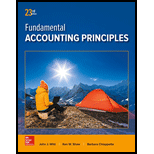
Concept explainers
Journal entries are the basic entries recoded as per the transactions being entered into by the business in its day to day operations in a chronological order.
Accounting rules regarding journal entries:
• Balance increases when: assets, losses and expenses are debited and liabilities, gains and incomes get credited.
• Balance decreases when: assets, losses and expenses get credited and liabilities, gains and incomes are debited.
Accounts Receivable:
Accounts receivable are the assets of the company as they depict the amount to be received in future from the customers to whom the products of the company have been sold. And thus it can be described as the potential asset addition sources hence an asset for the company.
Bad debts can be described as that value of accounts receivable which are regarded by the companies as no more collectible or the potential customers who were liable to make such payments are not in situation to do so. Hence bad debts are a loss and thus it ultimately decreases the assets of the company.
To prepare: Journal entries.
Want to see the full answer?
Check out a sample textbook solution
Chapter 9 Solutions
Fundamental Accounting Principles
- Brighton Audio produces and sells portable speakers. Each speaker sells for $45, and the variable cost per unit is $28. The company's fixed costs are $60,000, and it expects to sell 5,000 units. What is the contribution margin per unit?arrow_forwardA company's new product launch is expected to generate additional sales revenue of $40,000 with no increase in costs. If the company's tax rate is 35%, what is the after- tax income from this increase in revenue?arrow_forwardDelta Pack Ltd. produces custom packaging. The total manufacturing cost for producing 10,000 boxes is $95,000. Of this amount, $25,000 represents total variable costs. What would be the total production cost if the company produces 14,000 boxes?arrow_forward
- NovaTech Inc. had an accounts receivable balance of $150,000 at the beginning of the year and $180,000 at the end of the year. What is the percentage change in accounts receivable at year-end? a) 15% decrease b) 20% increase c) 25% increase d) 30% increasearrow_forwardCan you help me solve this general accounting problem using the correct accounting process?arrow_forwardSubject:-- accounting questionsarrow_forward

 AccountingAccountingISBN:9781337272094Author:WARREN, Carl S., Reeve, James M., Duchac, Jonathan E.Publisher:Cengage Learning,
AccountingAccountingISBN:9781337272094Author:WARREN, Carl S., Reeve, James M., Duchac, Jonathan E.Publisher:Cengage Learning, Accounting Information SystemsAccountingISBN:9781337619202Author:Hall, James A.Publisher:Cengage Learning,
Accounting Information SystemsAccountingISBN:9781337619202Author:Hall, James A.Publisher:Cengage Learning, Horngren's Cost Accounting: A Managerial Emphasis...AccountingISBN:9780134475585Author:Srikant M. Datar, Madhav V. RajanPublisher:PEARSON
Horngren's Cost Accounting: A Managerial Emphasis...AccountingISBN:9780134475585Author:Srikant M. Datar, Madhav V. RajanPublisher:PEARSON Intermediate AccountingAccountingISBN:9781259722660Author:J. David Spiceland, Mark W. Nelson, Wayne M ThomasPublisher:McGraw-Hill Education
Intermediate AccountingAccountingISBN:9781259722660Author:J. David Spiceland, Mark W. Nelson, Wayne M ThomasPublisher:McGraw-Hill Education Financial and Managerial AccountingAccountingISBN:9781259726705Author:John J Wild, Ken W. Shaw, Barbara Chiappetta Fundamental Accounting PrinciplesPublisher:McGraw-Hill Education
Financial and Managerial AccountingAccountingISBN:9781259726705Author:John J Wild, Ken W. Shaw, Barbara Chiappetta Fundamental Accounting PrinciplesPublisher:McGraw-Hill Education





